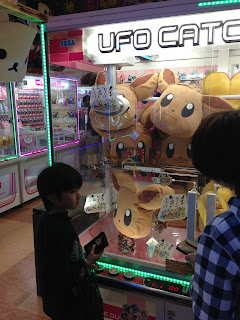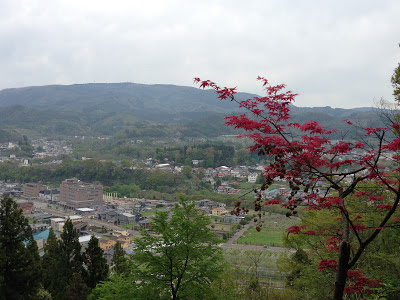Let’s take a little adventure
through the past few days. I was back at な中学校for
the first half of this week. There is a huge dichotomy of energy between each
grade and each class. For one thing, the first year students are anything from
shy to friendly to freaking genki…
Oh right. Genki. What’s genki, you
ask?
“Genki” is a state of mind and
well-being that the Japanese people live by: to be genki is literally to say
that you are just about as well as it gets. When you ask someone how they are:
“Genki desuka?”
And they say:
“Genki desu.”
The near-to-English translation is “How
is your state of being?” It’s sort of an all-encompassing frame of mind, to be
genki. It is to be happy, to be healthy, to be energetic in body and mind. ALTs
and NSs are expected to be 100% genki because that sets a positive mood for the
class and helps you give off positive energy that will make students want to
communicate with you.
Well, that latter half is a little “drink
the Kool-Aid” but if you think about it, it’s better to put on a smile and give
off that good positive energy when you’re working: best not to drag your
baggage into the school with you. There’s not enough room under your desk or in
your shoe locker for that.
Anyway, some of these students are
genki to the point of hyperactivity! I love teaching the first years because
the majority of students are very genki indeed. That said, Monday was an
exhausting day! The students were practicing the “Do you like/have….Yes, I do/
No, I don’t” dialogue, and the teacher’s idea for the lesson was to have the
students play Interview BINGO! They walked around with game boards and asked
each other questions like “Do you have a car?” and “Do you like ramen?” to get
signatures. Once they were done, the teacher asked everyone to sit and she
called out students’ names (and her name and mine for good measure). Students
who got BINGO came to me for a sticker prize! So of course, anytime you let
hyperactive twelve year olds leave their seats and abandon the typical
structure of the typical class, it’s like keeping a basket of puppies from
licking your face; a fat kid away from the all you can eat patisserie bar; a
honey badger away from the soft, tender, helpless baby abandoned in the woods.
..
At the end of the class, the
teacher let the students practice the dialogue again by asking me what Japanese
things I like. For the record, I like Godzilla, dogs, and tsukemono, I don’t
like natto and I haven’t tried fish sausage yet so please stop asking! By far,
though, the most interesting class was the one in which one boy kept asking
what I like to drink.
Biiru?
Wiski?
Sake?
Wain?
Umeshu? (plum wine)
What could I do? The teacher kept
calling on him: I had to answer. So as not to seem like an utter booz-oholic, I
said:
No.
No.
Yes.
Yes.
Yes!
Of course, they got a kick out of
it, so communication achieved!
As I mentioned on Sunday, my
company was doing school visits on Tuesday to see how I’m doing. Anyone who has
known me for half a millisecond knows I have a tendency to read too far into
things and then subsequently stress over nothing. Turns out, this was another
one of those cases, though I’m proud to say I wasn’t all that concerned. Any time you know your boss is
going to be looking over your shoulder, you straighten up a bit, right? It was just
like that, nothing more.
I was teaching a class at the time
the company employee came around to my school, the last one she visited that
day. So after school, I met her outside and we chatted a bit. She told me that
the teachers think the students enjoy English class and the teachers think I am
“very Japanese.” If you want a crash course in being Japanese, stay tuned for a
mini lesson soon! Here’s a precursor: it’s not hard.
After the formal discussion, she
asked me how my Japanese was coming along and I told her, with some broken
Japanese-English that I was practicing…to which she said “Here, this is from
the company! We all have one!” and she gave me a Japanese lesson book! It’s
great! It’s written in hiragana and katakana, no English anywhere! The cute
little illustrations help with translation so now it’s all about grammatical
structure. If you keep in mind that you end up sounding like Yoda if you
translate it to English, it’s pretty easy to keep up.
When I got home, I received a call
from my head teacher. He makes these telephonic rounds every few weeks to make
sure we noobs are doing alright. You know:
“How do you like your schools?” (“Yes,
no problems there.”)
“Are the teachers and students
treating you okay?” (“Of course! Everyone is so nice!”)
“How do you like the town?” (“Yep,
always something going on hereabouts.”)
“Are you getting out of your tiny
apartment once in a while and breathing fresh air and blinking in the sunlight
like a terrified Morlock?”
Really? I’m eating, drinking and
bathing among other things like a human too. I’m okay. If I gotsa problem, I’mma
let you know. I closed out the conversation by
saying “Everything is going well. I have no complaints and the schools are all
easy to get to. I haven’t been late yet.”
Big mistake.
Guess who forgot to turn on her
alarm last night and ended up sleeping until 7:08am today?
A grand total of 22
minutes before I had to leave! Cussing a mental blue streak vivid enough to
knock any Care Bear on its ass in defeat, I was up and the race was on. I
actually managed to make it out the door on time. Good thing every school comes
fully equipped with its own Redhii Revival Kit, aka coffee and tea service: I
had to skip that crucial a.m. cup to get to the school by 8:00, but at least
the coffee and tea at な is free and you
can help yourself to all you want.
It also certainly helped that the
second and third year students were doing an English Speech Test today, so all
I had to do was listen to each student give a brief speech about either their
Golden Week or an aspect of Japanese culture, respectively, then give feedback.
I learned mostly about origami, senbei (Japanese crackers), Tanabata and of
course, natto.
Fun facts I learned from students:
Origami: Some students make origami
as a sign of respect for their senpai, or their elders on their club sports
teams.
Senbei: The most popular flavor of
the large, round, flat cracker is soy sauce.
Tanabata: A holiday held on July 7th
where the legend goes two lover gods, Orihime and Hikoboshi, meet in the Milky
Way. The Japanese people celebrate by setting off elaborate fireworks.
(I wonder what that’s a metaphor for?)
Natto: “it used to be made in straw
but now it’s made by machine.”
Or, so says one third year boy. I’ll
take his word for it.
Cool, ne?
To close, tomorrow, I move on to 矢中学校 for a few days. Tomorrow
is actually when students are taking their first midterm exam, so I’ll spend
the day in the teacher’s room planning for future lessons and studying this
kick ass Japanese text book…and drinking all the sweet Redhii nectar my little
over-caffeinated heart can stand. Also, on Friday, there will be no school
lunch provided.
Mayhaps I’ll make my first bento?
 And now, because reportedly, June
marks the rainy season in Japan, here are some pictures of the Contemporary
Poetry Park near my apartment on the last sunny day we had this week. Enjoy!
And now, because reportedly, June
marks the rainy season in Japan, here are some pictures of the Contemporary
Poetry Park near my apartment on the last sunny day we had this week. Enjoy!












































